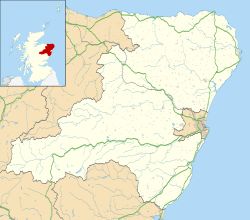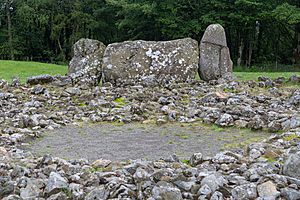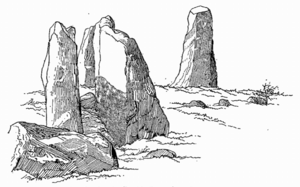Loanhead of Daviot stone circle facts for kids
| Location | Scotland |
|---|---|
| Region | Aberdeenshire |
| Coordinates | 57°20′59″N 2°25′16″W / 57.349722°N 2.421111°W |
| OS grid reference | NJ747288 |
| Type | Recumbent stone circle |
| Diameter | 21 metres (69 ft) |
| Height | 2.26 metres (7 ft 5 in) maximum |
| History | |
| Material | Granite |
| Periods | Neolithic, Bronze Age |
| Site notes | |
| Excavation dates | 1934, 1935 |
| Archaeologists | H.E. Kilbride-Jones |
| Management | State |
| Public access | Yes |
| Designated | 1925 |
| Identifiers | |
| Historic Environment Scotland | SM90202 |
The Loanhead of Daviot stone circle is an ancient monument in Aberdeenshire, Scotland. It's a special type of stone circle called a recumbent stone circle.
This circle has a very large stone lying on its side, called the recumbent stone. On each side of it are two tall, pillar-like stones called flankers. There are also eight other upright stones, known as orthostats, forming a circle about 21 meters (69 feet) wide. Inside the circle, there's a low, round mound of stones called a kerbed ring cairn.
Archaeologists have worked to restore the site. They excavated it in 1934 and 1989. This helped us understand how it looked long ago. The recumbent stone faces slightly south-south-west. Close by, there's also an ancient burial ground where people were cremated.
Contents
What are Recumbent Stone Circles?
Recumbent stone circles are unique ancient monuments. They are found mostly in northeast Scotland, especially in Aberdeenshire.
These circles feature a large stone, the "recumbent," lying flat. Its longest side usually points between south and southwest. Two tall "flanker" stones stand on either side of the recumbent. The rest of the circle is made up of upright stones, called "orthostats."
Most recumbent stone circles originally had a low, round mound of stones inside. This mound is called a "ring cairn." Over thousands of years, many of these cairns have worn away. These circles might have developed from similar ancient sites like the Clava cairns found near Inverness.
Exploring Loanhead of Daviot
The Stone Circle
The Loanhead of Daviot stone circle sits on a ridge. It overlooks the village of Daviot in northeast Scotland. This site became a protected ancient monument in 1925. The Scottish government took care of it starting in 1933.
People built this circle from granite during the early Bronze Age. It's one of the few recumbent stone circles that still has all its original stones. This includes the recumbent stone, its two flankers, and eight other upright stones. The circle measures about 21 meters (69 feet) across. The recumbent stone and its flankers are located on the south-south-west side.
The large recumbent stone is slightly angled towards the south. It has a natural crack running down its length. This makes it look like two parallel slabs. The taller slab, closer to the inside of the circle, is about 1.8 meters (5.9 feet) high. The recumbent and flankers sit on a platform of boulders.
During excavations in 1934–1935, archaeologists restored the western flanker. It is 2.26 meters (7.4 feet) tall. The eastern flanker, which is 1.73 meters (5.7 feet) tall, had fallen. It was put back into its original spot. This eastern flanker has a single small hollow, called a cupmark, on its inner side. Another stone nearby has twelve shallow cupmarks.
Archaeologists found pottery pieces all over the site. The oldest pieces date back to the Neolithic period.
The Central Mound
The central mound, or cairn, is somewhat round but has many sides. It is about 16 meters (52 feet) across and up to 0.3 meters (1 foot) high. Since it has been rebuilt, its original look is hard to know. There are 38 kerb stones around the southern edge of the cairn. These stones get bigger as they get closer to the recumbent stone.
In 1989, stones were removed from the middle of the cairn. This created an open space, or "court," about 4.3 meters (14 feet) wide. Behind the recumbent stone, the line of kerb stones becomes double. This is similar to what is seen at the Tomnaverie stone circle. A platform of stones once stretched from the kerbstones out to the upright stones. Most of these stones were gone before the excavations.
Archaeological Discoveries
The Stone Circle and Cairn
Frederick Coles was the first person to carefully record the site in 1901. He found the east flanker and four other upright stones lying on the ground. Only the top parts of the split recumbent stone were visible. He thought the two slabs had always been separate.
Later, in 1918, James Ritchie believed the recumbent stone was once a single block that had split. He also found the cupmarks on the stones.
In 1934, Howard Kilbride-Jones led a big excavation. They found cremated bones and over 100 pieces of pottery. These pottery pieces likely came from the late Bronze Age. Kilbride-Jones also found an open area or a large pit in the center of the cairn. He believed the recumbent stone was placed before the cairn was built.
In summary, the oldest pottery found is from the Neolithic period. The recumbent stone was set up in the early Bronze Age. Most of the pottery pieces found are from the late Bronze Age. In 1989, the stones were removed from the central area of the ring cairn. The site was then covered with grass again.
The Cremation Cemetery
Towards the end of the 1934 excavation, Kilbride-Jones found a small stone box, called a cist. It was about 56 by 32 centimeters (22 by 12.5 inches) inside. This cist held a small "incense cup" and cremated human bones.
The next year, he dug more and discovered the cist was on the edge of a sunken wall. This wall was about 10 meters (33 feet) across. It enclosed a cemetery, which was a complete surprise. It is now thought that this wall was made of timber that later burned down, and then stones were packed around it.
This cemetery dates back to between 2000 and 1000 BCE. It was a place where many cremations happened. Archaeologists found the cremated remains of at least 31 people. These remains were spread among twelve urns and thirteen pits. Sadly, the cremation remains can no longer be found, so scientists cannot use carbon dating on them today.







